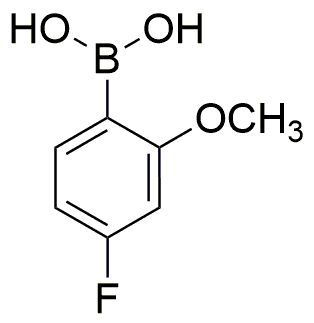4-Fluoro-2-methoxyphenylboronic acid is widely utilized in research focused on:
- Pharmaceutical Development: This compound serves as a key intermediate in the synthesis of various pharmaceuticals, particularly in the development of anti-cancer agents. Its ability to form stable complexes with biomolecules enhances drug efficacy.
- Organic Synthesis: It is employed in Suzuki coupling reactions, which are essential for constructing complex organic molecules. This application is particularly valuable in the production of agrochemicals and fine chemicals.
- Material Science: The compound is used in the creation of functionalized materials, such as polymers and nanomaterials, which have applications in electronics and sensors due to their unique electronic properties.
- Bioconjugation: It plays a significant role in bioconjugation processes, allowing researchers to attach biomolecules to surfaces or other compounds, which is crucial in diagnostics and therapeutic applications.
- Research in Chemical Biology: The compound is utilized in studies aimed at understanding biological processes, particularly in the development of targeted therapies that can selectively interact with specific biological targets.
Información general
Propiedades
Seguridad y normativas
Aplicaciones
4-Fluoro-2-methoxyphenylboronic acid is widely utilized in research focused on:
- Pharmaceutical Development: This compound serves as a key intermediate in the synthesis of various pharmaceuticals, particularly in the development of anti-cancer agents. Its ability to form stable complexes with biomolecules enhances drug efficacy.
- Organic Synthesis: It is employed in Suzuki coupling reactions, which are essential for constructing complex organic molecules. This application is particularly valuable in the production of agrochemicals and fine chemicals.
- Material Science: The compound is used in the creation of functionalized materials, such as polymers and nanomaterials, which have applications in electronics and sensors due to their unique electronic properties.
- Bioconjugation: It plays a significant role in bioconjugation processes, allowing researchers to attach biomolecules to surfaces or other compounds, which is crucial in diagnostics and therapeutic applications.
- Research in Chemical Biology: The compound is utilized in studies aimed at understanding biological processes, particularly in the development of targeted therapies that can selectively interact with specific biological targets.
Documentos
Hojas de datos de seguridad (HDS)
La SDS proporciona información de seguridad completa sobre la manipulación, el almacenamiento y la eliminación del producto.
Especificación del producto (PS)
La PS proporciona un desglose completo de las propiedades del producto, incluida la composición química, el estado físico, la pureza y los requisitos de almacenamiento. También detalla los rangos de calidad aceptables y las aplicaciones previstas del producto.
Certificados de análisis (COA)
Busque certificados de análisis (COA) ingresando el número de lote del producto. Los números de lote y de partida se pueden encontrar en la etiqueta de un producto después de las palabras "Lote" o "Lote".
Número de catálogo
Número de lote/lote
Certificados de origen (COO)
Este certificado de origen confirma el país en el que se fabricó el producto y también detalla los materiales y componentes utilizados en él y si se deriva de fuentes naturales, sintéticas u otras fuentes específicas. Este certificado puede ser necesario para cumplir con las normativas aduaneras, comerciales y regulatorias.
Número de catálogo
Número de lote/lote
Hojas de datos de seguridad (HDS)
La SDS proporciona información de seguridad completa sobre la manipulación, el almacenamiento y la eliminación del producto.
DownloadEspecificación del producto (PS)
La PS proporciona un desglose completo de las propiedades del producto, incluida la composición química, el estado físico, la pureza y los requisitos de almacenamiento. También detalla los rangos de calidad aceptables y las aplicaciones previstas del producto.
DownloadCertificados de análisis (COA)
Busque certificados de análisis (COA) ingresando el número de lote del producto. Los números de lote y de partida se pueden encontrar en la etiqueta de un producto después de las palabras "Lote" o "Lote".
Número de catálogo
Número de lote/lote
Certificados de origen (COO)
Este certificado de origen confirma el país en el que se fabricó el producto y también detalla los materiales y componentes utilizados en él y si se deriva de fuentes naturales, sintéticas u otras fuentes específicas. Este certificado puede ser necesario para cumplir con las normativas aduaneras, comerciales y regulatorias.


